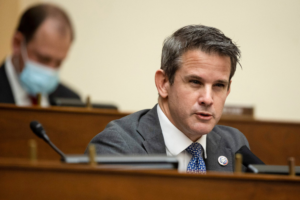Oakland was the latest stop in a community listening tour by the state’s Reparations Task Force, the first committee of its kind in the nation.
Back in 2020, California formed the nation’s first statewide task force to explore the idea of government reparations for Black people. Over the past year, the committee has been organizing listening sessions with Black residents to gather testimonials and ideas as it works toward presenting a policy framework to lawmakers.
Oaklandside contributor Corey Antonio Rose attended a recent task force listening session in Oakland and spoke to participants there about why reparations are important to them. Rose also interviewed Kamilah Moore, the task force chairperson, about what exactly reparations might entail, who would stand to benefit, and what comes next.
You can listen to the full audio report and read a slightly edited version of the audio transcript below. This report also aired on the KALW program Crosscurrents.
We know the United States’ founding history is deeply embedded in racialized violence, from enslavement to present-day disparities in areas as wide-ranging as education, banking, healthcare, and criminal justice, to name only a few.
In 2020, California took a step toward addressing these harms by passing Assembly Bill 3121, a landmark piece of legislation that created the nation’s first-ever statewide task force on reparations for Black people. Now that task force is traveling the state to gather testimonials and input from Black Californians about what reparations would mean for them.
“And when I think about what Oakland has gone through with the closures of school that impact predominantly our kids… It’s a sin.”
That’s Allie Whitehurst, a retired educator in Oakland, and one of nearly 2.6 million African Americans in the state who may be eligible for reparations. Here she is, talking about what reparations could mean for educators like her at a recent task force listening session, held in Oakland in late May:
“To use resources for people who look like me to get into classrooms, removing the barriers, would be one of the ways in which we can provide reparations for our people now and show what respect we have for those on whose shoulders we stand,” said Whitehurst. “As an educator, seeing the plight of education—most recently in Oakland public schools—and the pain and the destruction that’s happening—it is due.”
The idea of reparations as a way to address systemic harm against Black folks in the United States is nothing new. You may have heard of the “40 acres and mule” that we never got, or the 1968 Kerner Commission report that the federal government ignored. But with the introduction of AB 3121, the folks on the frontline of this work are saying that Black people in the U.S. are closer to reparations than we’ve been since the end of the Civil War.
“The political climate has changed since then, but not so much in some ways.”
That’s Kamilah Moore, chairperson of the California Reparations Task Force. She’s leading the nine-member task force in its mission to help answer some big questions about reparations, should they happen: what the payments would be used for, who should receive them, and how the state would hand them out.
“The dictionary definition of reparations is essentially making the amends for a wrong that one has done by paying money or otherwise helping those who have been wronged,” said Moore. “But in this particular context of reparations, it is about the United States making amends to those who are direct descendants of those who experienced U.S. slavery and Jim Crow.”
That means making amends for the 400 years of free labor that made it possible for the United States to accrue such massive wealth—as well as the terrorizing of Black folks by groups like the KKK, racist Jim Crow laws, discriminatory practices like redlining, poll taxes, gentrification and over-policing in Black neighborhoods, the prison industrial complex, and more.
“Any of our recommendations that the task force creates must comport to international human rights law standards,” said Moore. “And under international law, reparations must come in five forms for it to be fully comprehensive, so compensation or a check is just one of the forms of reparations under international law. But there are four other forms which include:
“rehabilitation…”
This could include things like medical and psychological care as well as legal and social services. It could be free education, free healthcare, and addressing other systems that still disadvantage Black folks.
“restitution…”
The return of land, or the opportunity to own land.
“satisfaction…”
In other words, apologies: Taking down the racist statues and changing our history books to reflect what actually happened.
“…and guarantees of non-repetition.”
That means legislative, corrective action to make sure it doesn’t happen again.
“This work is urgent — in the California Reparations Task Force bill, it states that we have two years to do this work. But at the same time, you know, there are Black Californians who are suffering today,” said Moore.
The task force just released its initial report—500 pages full of why California owes reparations. But according to AB 3121, the committee is also supposed to educate and inform the public about the call for reparations.
So the task force has been partnering with organizations already advocating for reparations, like the Coalition for a Just and Equitable California, to host listening sessions, like the recent one in Oakland.
“People in their own specific communities actually speak about the needs of those specific communities in the different places that we’ve gone.”
That’s Chris Lodgson, one of the lead organizers with CJEC, who has been leading community discussions on reparations in cities all over California for a year now. I spoke to Lodgson after his presentation at the Oakland listening session. He said he’s been surprised by some of the issues that people raise, like at one recent session in Marin City.
“One of the things that struck me about the Marin City meeting was the focus on the environmental harm and the flooding of that city, and the coastal issues and the land reclamation issues that Black folks have been working through down there,” he said. “That really struck me because it was the first time actually I heard Black folks talk about environmental harm, to actually be victims of it.”
Many of the problems that have plagued Oakland’s Black communities for decades—homelessness, gentrification, a lack of economic opportunity—are the same ones hitting Black folks hard in other cities. I spoke with LuvVon Brown, a sales executive originally from Seaside, California, who attended the Oakland listening session. She told me about her experience watching her community change.
“Seaside California was a historically black town all the way going back to the 1940s because Black people were not allowed to buy homes in Monterey County or the city of Monterey, Del Rey, Oaks, Carmel… So Black people just naturally settled in Seaside,” said Brown.
“Growing up there, it was a Black middle class, highly educated, like, mecca. It was like a little Atlanta, if you would. Everybody owned their home, everybody, you know, lived there comfortably. And then around 2005, you start to see the cost of living just trickle up and the jobs weren’t keeping up with the cost of inflation.”
When I left California and moved back, I was shocked at how much it had changed,” she said. “I mean, Black people just were not there. People had to sell their homes, They had to move because they just can’t afford to live in California. And that breaks my heart.”
Brown, who lives in Walnut Creek now, said it’s been especially painful for her to see the state become so unaffordable, given the way California built its wealth and reputation on the backs of Black folks.
“Music, entertainment, clothing, slang, I mean, everything. This ain’t even California. I feel bad people moved here to California because it’s like, where’s the parties? Where’s the club? Where did this go? I’m like, ‘Girl, it ain’t here no more because the creative people can’t afford to live here anymore.’”
So what could reparations look like for Brown?
“Affordable rent. We can’t have a Black community if we don’t have Black housing. And people, Black people need to be able to live in and be able to own where they live.”
That’s exactly one of the actions that were recommended by the task force in its initial report—the establishment of a state-subsidized mortgage system that guarantees low-interest rates for Black mortgage applicants.
Whether that becomes a reality will depend on lawmakers, said Moore.
“This task force has the power to study and develop reparations proposals, but it’s ultimately going to be up to the California state legislature to enact our proposals.”
But who are we talking about when it comes to receiving reparations?
The task force answered the question in March of this year: Reparations would only be for those with a direct lineage to freed or enslaved Black people who were living in the United States prior to 1900.
Ways to prove eligibility could include checking census records, social security indexes, World War II draft cards, or death indexes, which are all available online.
According to CJEC, that would mean about 80-90% of the Black folks living in California would be eligible. But even those who aren’t, like Black immigrants, stand to benefit in other ways, said Moore.
“If Black immigrants suffer in the United States by virtue of proximity to us, then when we get reparations, they will benefit by virtue of being in proximity to us,” she said. “There are other forms of reparations as well, like rehabilitation, restitution, satisfaction, guarantees of non-repetition—and Black immigrants could definitely benefit from those other forms.”
Lodgson echoed that sentiment: By reforming the systems that hurt the most marginalized of us, the experience is made better for everyone. “When you repair this community, you also are helping to repair the rest of the country,” he said.
The task force is going on a short break until September, but if you’re interested, the past year of meetings and expert testimony is available online at oag.ca.gov/ab3121, where you can also read the interim report summarizing the first year of research.




